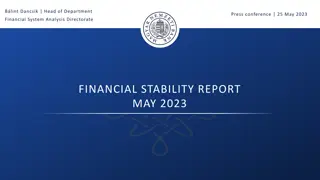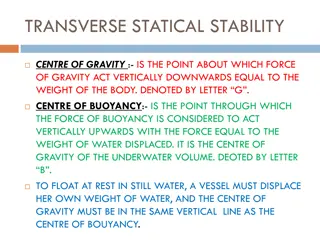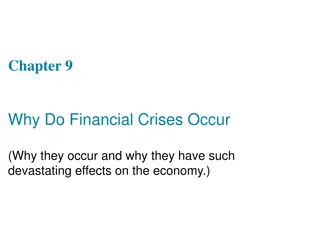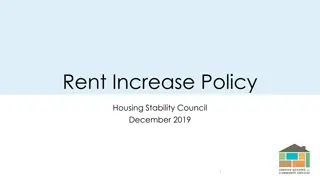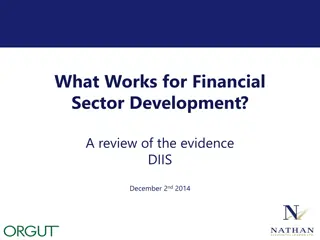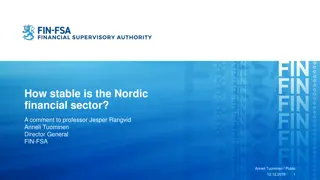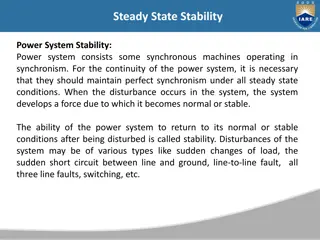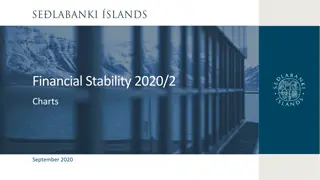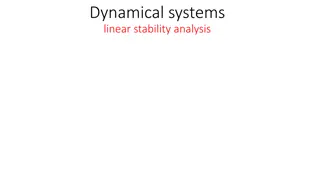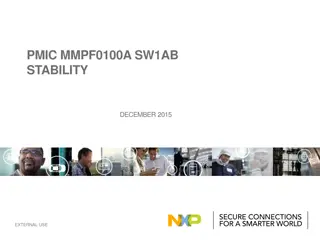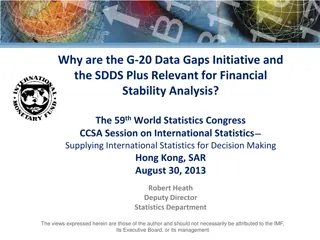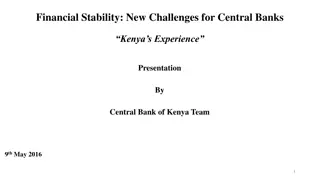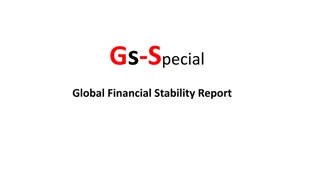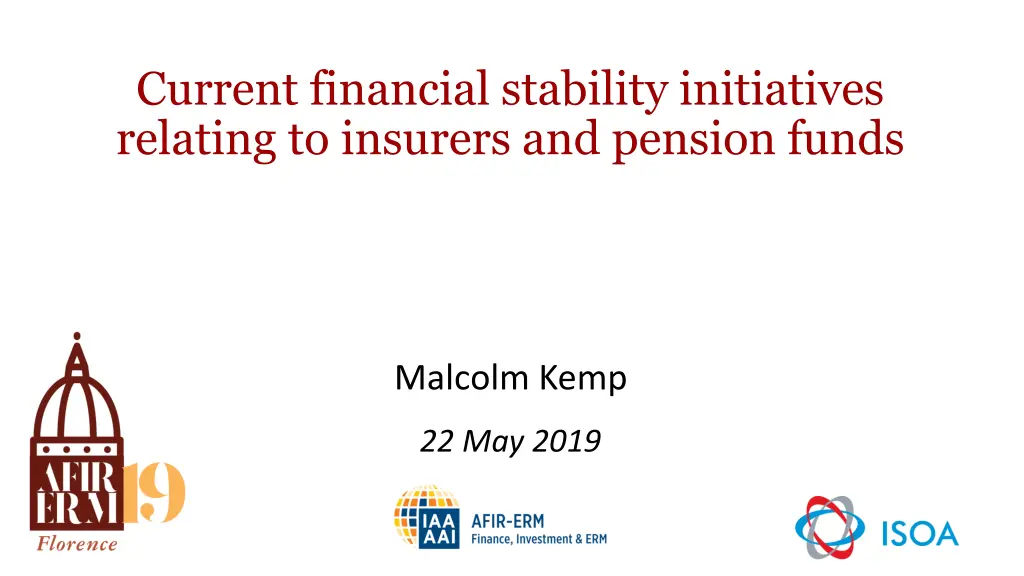
Financial Stability Initiatives for Insurers and Pension Funds
Explore current financial stability initiatives concerning insurers and pension funds, including models of systemic risk, macroprudential proposals, historical context of crises, and comparisons between banks and insurers' business models. Gain insights into systemic risks and regulatory measures in the financial sector.
Download Presentation

Please find below an Image/Link to download the presentation.
The content on the website is provided AS IS for your information and personal use only. It may not be sold, licensed, or shared on other websites without obtaining consent from the author. If you encounter any issues during the download, it is possible that the publisher has removed the file from their server.
You are allowed to download the files provided on this website for personal or commercial use, subject to the condition that they are used lawfully. All files are the property of their respective owners.
The content on the website is provided AS IS for your information and personal use only. It may not be sold, licensed, or shared on other websites without obtaining consent from the author.
E N D
Presentation Transcript
Current financial stability initiatives relating to insurers and pension funds Malcolm Kemp 22 May 2019
Agenda Agenda Models of systemic risk Macroprudential proposals for insurers Insurers versus pension funds 2
Agenda Agenda Models of systemic risk Macroprudential proposals for insurers Insurers versus pension funds 3
Background Background Systemic risk Largely new term coined during 2007-09 Credit Crisis (the Global Financial Crisis ) Borrows from multiple disciplines and hence has multiple angles Financial stability The mandate given to bodies that have responsibility for mitigating systemic risk E.g. Financial Stability Board (FSB, global), European Systemic Risk Board (ESRB, EU) C.f. financial stability departments within e.g. EIOPA, BoE, ECB, Federal Reserve, IMF Macroprudential regulation/policy Regulation/policy that tries to tackle systemic risk and to foster financial stability 4
Historical context Historical context Earlier systemic crises included e.g. Savings and Loans Crisis, 1929 Wall Street Crash, LTCM, Continental Illinois ( Too Big To Fail ), LDC Debt Crisis, 2007-2009 GFC particularly impacted the banking sector (and related areas such as shadow banking ) as did many previous systemic crises But regulators don t think insurers are immune from systemic risk C.f. AIG (although the insurance industry argue that its near failure wasn t insurance related), some EU insurers during the GFC (particularly ones with significant CDO / CLO exposures) and e.g. ESRB December 2015 Report on systemic risks in the EU insurance sector (including exposure to long-term interest rates: low for long ) Ignoring possible ways in which systemic risks might influence, be magnified by or even possibly be created by insurers may focus too much on solving the last crisis rather than mitigating the next one 5
Different business models: banks vs. insurers Different business models: banks vs. insurers Banks A means of payment in exchange for goods and services Insurers A store of value, permitting deferred consumption and smoothing Risk pooling (As investors) invest long-term and gain from illiquidity premium Mainly liability-driven, less leveraged and often less exposed to runs Lower Monetary role industry mainly fulfils Other roles Comparative advantage Financial services Screen and finance short-term projects Largely asset-driven, often supported by leveraged balance sheets Higher Core business activities Exposure to systemic risk from any one firm? Risk that safety net costs fall on government? Higher (more essential to current economic activity) Lower Source: Nematrian and Kemp (2017). Systemic risk: A Practitioner s Guide to Measurement, Management and Analysis 6
Models of systemic risk Models of systemic risk Domino View Tsunami View Individual firms System of firms Shock to assets One firm fails Being large, complex and interconnected creates bigger risks Common exposures, not direct interconnections create vulnerabilities Correlated sales and fire sales Chain defaults Funding / lending stops Confidence declines Damage to real economy Source: Nematrian and Kemp (2017). Systemic risk: A Practitioner s Guide to Measurement, Management and Analysis. Adapted from IMF (2016). Global Financial Stability Report, April 2016, Chapter 3: The Insurance Sector - Trends and Systemic Risk Implications 7
Agenda Agenda Models of systemic risk Macroprudential proposals for insurers Insurers versus pension funds 8
European Systemic Risk Board (ESRB) European Systemic Risk Board (ESRB) ESRB set up by EU Regulation in December 2010 in response to GFC Part of the European System of Financial Supervision (ESFS) along with EBA, ESMA and EIOPA Responsible for macroprudential oversight of EU financial system and the prevention and mitigation of systemic risk. Operates primarily by persuasion: Its General Board is currently chaired by Mario Draghi (ECB president) Other permanent representatives include national central bank governors, chairs of EU sectoral supervisory bodies (EBA, ESMA, EIOPA), a representative of the EU Commission, Chairs and two Vice-chairs of the ESRB s Advisory Scientific Committee and Chair of the ESRB s Advisory Technical Committee Insurers and pension funds therefore more likely to interact with EIOPA or national supervisory authorities 9
ESRB (November 2018) ESRB (November 2018) Systemic risk type (insurers) Generic risk type Specific systemic risk Targets Options Contagion - - Mass lapses Number and pace of failures Transmitters Impact Recovery and resolution framework Targets Options Procyclicality 1. Symmetric capital requirements for cyclical risks Liquidity requirements - - - - - - Procyclicality Under-capitalisation Under-pricing Under-reserving Extending Solvency II reporting requirements 2. Mass lapses Discretionary intervention powers Bank-like activities Alignment of the treatment of loans Under-capitalisation (significant institutions) Extension of HLA concept Under-capitalisation Market-wide capital increases and dividend restrictions Source: ESRB (2018). Macroprudential provisions, measures and instruments for insurance (adapted) 10
EIOPA EIOPA European Insurance and Occupational Pensions Authority: three previous papers on macroprudential policy (in 2017 and 2018) plus 2019 Consultation Greater emphasis on Solvency II than ESRB, but mostly similar conclusions European Commission also raised topic in its call for advice from EIOPA on 2020 Solvency II Review EIOPA is asked to assess whether the existing provisions of the Solvency II framework allow for an appropriate macro-prudential supervision. Where EIOPA concludes that it is not the case, EIOPA is asked to advise on how to improve the following closed list of items: the own-risk and solvency assessment; the drafting of a systemic risk management plan; liquidity risk management planning and liquidity reporting; the prudent person principle. This assessment should be based on strong supporting evidence, also assessing the possible impact of such additional specifications of insurers behaviour and possible interactions with other Solvency II instruments. 11
EIOPA observations EIOPA observations Lessons from crisis include Supplement microprudential with macroprudential, and avoid conflicts if possible Identify sources of risk: include entity-based, activity-based sources and behaviour- based sources of systemic risk Widely acknowledged that traditional insurance activities generally less systemically important than banking, but insurance can also potentially create or amplify risks Conceptual approach focusing on: Triggering event, company risk profile, systemic risk drivers, transmission channels, sources of systemic risk Solvency II has many elements that can mitigate systemic risk 12
EIOPA (March 2019) EIOPA (March 2019) Tool Type of tool proposed for further consideration Enhanced reporting and monitoring Leverage ratio Capital and reserving-based Enhanced monitoring against market-wide under-reserving Capital and reserving-based Additional reporting on liquidity risk (*) Liquidity-based Liquidity risk ratios Liquidity-based Enhancement of Prudent Person Principle (PPP) (*) Exposure-based Enhancement of own risk and solvency assessment (ORSA) (*) Exposure-based Recovery plans (*) Pre-emptive planning Resolution plans (*) Pre-emptive planning Systemic Risk Management Plans (SRMP) (*) Pre-emptive planning Liquidity Risk Management Plans (LRMP) (*) Pre-emptive planning Intervention powers Capital surcharge for systemic risk Liquidity-based Temporary freeze on redemption rights Liquidity-based Concentration thresholds Exposure-based Source: EIOPA (2019) Systemic Risk and Macroprudential Policy in Insurance (adapted) (*) tools referred to in EU Commission call for advice on 2020 Review of Solvency II 13
IAIS (November 2018) IAIS (November 2018) International Association of Insurance Supervisors: Exposures potentially leading to systemic impact include: Liquidity risk, interconnectedness, lack of substitutability, other Liquidity risk: e.g. derivatives, securities lending transactions, backing liquid liabilities with illiquid assets Transmission channels include: Asset liquidation Exposure channel. Can be indirect (via macroeconomic exposures) or direct (via interlinkages, so distress at one institution can propagate to rest of financial system) Critical functions: interruption systemic if important for wider functioning and large market share Other E.g. Cyber-risk or widespread under-reserving without possibility to reprice (c.f. EIOPA) 14
IAIS Overview of supervisory policy measures IAIS Overview of supervisory policy measures Policy measure ICP ComFrame (IAIG) G-SII Macroprudential surveillance Enhance link of macroprudential monitoring to the supervisory framework Liquidity management & planning Strengthened enterprise risk management Requirements on insurers Disclosure requirements on liquidity risk Higher loss absorbency (HLA) Crisis management groups Crisis management and reporting Recovery plan Resolution plan Preventive and corrective measures based on macroprudential concern Powers of intervention Including reporting on the management of systemic risk (SRMP) [ ] Not applicable; [ ] Required as necessary only; [ ] Required; [ ] G-SII Policy measure Source: IAIS (2018) Holistic Framework for Systemic Risk in the Insurance Sector (adapted) 15
Agenda Agenda Models of systemic risk Macroprudential proposals for insurers Insurers versus pension funds 16
Pension fund interaction with systemic risk (1) Pension fund interaction with systemic risk (1) Limited regulatory focus to date on systemic risk C.f. EU IORP II Directive largely avoids specific solvency requirements Significant differences between jurisdictions Even within EU Social nature of pensions Is the pension system even part of the financial system? Pillar 1 / Pillar 2 / Pillar 3 and DB / DC Relative size of financial intermediaries (2014) (Percent of GDP) 450 400 350 300 250 200 150 100 50 0 USA Canada Euro area United Kingdom Japan Korea Insurers Banks Other financial institutions Pension funds Source: Nematrian and Kemp (2017). Systemic risk: A Practitioner s Guide to Measurement, Management and Analysis and IMF (2016) Global Financial Stability Report, April 2016, Chapter 3: The Insurance Sector - Trends and Systemic Risk Implications (adapted) 17
Pension fund interaction with systemic risk (2) Pension fund interaction with systemic risk (2) Usual (Anglo-saxon?) policymaker view: pension funds have long-term investment horizons and probably make a positive contribution to financial stability Typically unleveraged (but derivatives, securities lending, asset management links?) But maybe only true in the past, when DB schemes were open, well-funded (or at least benefits were substantially discretionary) and the norm across industry Challenges include: DB funding (and buy-out!) shortfalls, demographics Optimistic asset return assumptions (e.g. some US local government schemes) Possible exposure channels: Centralised Pension Protection Schemes Corporates needing to divert funds from investment towards underfunded pension schemes? Breakdown of social contract underlying pension provision? 18
For now (in EU) For now (in EU) EIOPA December 2018 Financial Stability Report: Current macroeconomic environment and ongoing low interest rates continue to pose challenges for European occupational pension fund sector. Sudden increase in yields might also be problematic depending on accounting treatment For now, focus is principally on monitoring, reporting and (system-wide) stress testing: EIOPA closely monitors potential negative impacts of macroeconomic developments on the IORP sector and financial stability through stress test exercises Recent EIOPA IORP stress tests have included a common assessment framework which aims to quantify exposures (including benefit security mechanisms) in a market consistent manner Potentially challenging for pension funds to comply with 19
Summary Summary Models of systemic risk Regulators accept insurance is different to banking, but still think insurance has some systemic relevance Domino versus tsunami model Activity-, entity- and behavior-based drivers Macroprudential proposals for insurers A range of interested regulatory bodies A recent flurry of proposals, but with many common strands Insurers versus pension funds Pension funds usually considered stabilisers But maybe less true now than in the past, depth of analysis increasing 20

